Veterinary Advice Online: Canine Parvovirus (Parvo).
This article contains information on a range of topics designed to fully educate pet owners about Canine Parvovirus in dogs and puppies.
Parvovirus Contents:
1) What is parvovirus? - this section contains a basic definition about what canine parvo virus is.
2) Which dogs are at risk of parvo? - this section includes information on age and breed predispositions.
3) How do animals catch parvo? - this section contains information about where and how animals can catch parvo.
4) What does parvo do to your dog? - this section contains information on how parvoviruses work (how they replicate and destroy cells etc.) and how they affect tissues such as the intestine and bone marrow to create the disease symptoms seen.
5) How is parvo diagnosed? - this section describes how vets test for parvo and includes information on false positive and false negative test results that can occur.
6) How is parvo treated? - this section includes information on treatment modalities and monitoring required.
7) What complications can occur as a result of parvo infection?
8) What is the cost of treating parvo?
9) What is the prognosis for parvo?
10) How to prevent parvo? - this section contains general advice on prevention of parvovirus for pet owners.
11) How to prevent parvo in high risk situations? - this section contains useful tips and hints for preventing canine parvo virus infection and spread in situations with high viral contamination (e.g. contaminated breeding facilities, contaminated homes).
12) How do you disinfect the environment following parvovirus contamination?
WARNING - IN THE INTERESTS OF PROVIDING YOU WITH COMPLETE AND DETAILED INFORMATION, THIS SITE DOES CONTAIN MEDICAL AND SURGICAL IMAGES THAT MAY DISTURB SOME READERS.

1. What is Parvo?
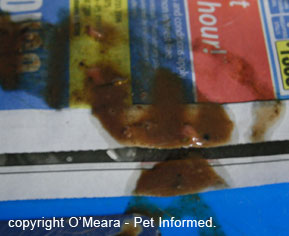 Parvo is a severe, often life-threatening disease of the intestinal tract and bone marrow (and sometimes other organs) of dogs and other canids that is caused by one of a number of strains of parvovirus. Currently, four main strains of infectious parvovirus have been identified: CPV-2 (the original virus) and its newer strains CPV-2a, CPV-2b and CPV-2c.
Parvo is a severe, often life-threatening disease of the intestinal tract and bone marrow (and sometimes other organs) of dogs and other canids that is caused by one of a number of strains of parvovirus. Currently, four main strains of infectious parvovirus have been identified: CPV-2 (the original virus) and its newer strains CPV-2a, CPV-2b and CPV-2c.
Also termed canine enteritis virus, a 'typical' case of parvo virus generally presents to vets as young puppies which look very unwell (they have no energy and are sad and lethargic), often with varying degrees of vomiting (sometimes blood filled), diarrhea (sometimes blood-filled), dehydration, inappetence, shock, abdominal pain and fever.
These puppies often come from lower socioeconomic backgrounds and are of uncertain vaccination history, or they have been recently purchased from, or exposed to, places with high environmental parvo virus levels (such as some breeding facilities and pet shops and even vet clinics). It is not uncommon to see puppies purchased from pet shops (where their background can be uncertain) and 'puppy farms' (often lots of overcrowding of animals and poor hygiene and disease control) become sick from parvo. Puppies that are malnourished or harboring other intestinal diseases (worms, bacterial pathogens) may be worse affected.
Note - parvoviruses also affect cats. Affected cats present with similar disease signs to dogs (bloody diarrhoea, vomiting, bone marrow suppression, severe unwellness): a condition termed
feline panleukopenia or
feline parvo (it is sometimes misnamed feline distemper by cat fanciers, but it is not a distemper virus). The usual virus responsible for feline parvovirus is not the same virus strain as that affecting the dogs, however some of the strains of canine parvo (CPV-2a and CPV-2b) can infect cats and have been known to cause disease in felines.

2. Which dogs are at risk of canine parvovirus?
Generally young, unvaccinated (or not fully-vaccinated) puppies, under 6 months of age are the most prone to parvovirus. Puppies that are vaccinated, but which do not respond adequately (fail to mount a protective immune response) towards their vaccinations are also at risk (see our vaccination failure page for details).
Puppies that have not been fully immunized against parvo are at risk of contracting the disease if their owners take them out into public places (where long-living parvo virus organisms could be ingested) or let them meet and greet other dogs (who could potentially be non-clinical carriers of the virus and pass it on to other pets). Even if puppies are not inappropriately socialized, owners can bring the virus home to their under vaccinated animals (thereby infecting them) by not being sufficiently hygienic following visitations to environments where there has been parvo.
Breed predispositions:
As veterinarians, we have noticed that some breeds, particularly the black and tan breeds (e.g. dobermann, rottweiler, Staffordshire bull terrier) are particularly prone to canine parvovirus infection. This is reflected in most textbooks, which also describe these breeds (and some others, including the German shepherd dog and Labrador) as being of higher risk.
One could make the point that these breeds are the kind commonly chosen by irresponsible, macho owners who are unlikely to get their dogs vaccinated, so naturally vets would see a lot of them with parvo. The fact remains, however, that even when these dog breeds have been fully vaccinated, adequately isolated during their unvaccinated-period and should have been protected, they still seem to be over-represented among the sick, parvo positive dogs that veterinarians see. Whether this is due to an innately poorer immune response in these breeds or due to prolonged maternal immunity in these breeds is uncertain (see our vaccination failure section for more).
Can older, fully-vaccinated dogs get canine parvovirus?
It is much rarer to get cases of parvo in older dogs that have been protected by vaccination. It can, however, occur if the dog:
1) encounters a new strain of parvovirus in the environment that is different from the strain it has been vaccinated against, making it unprotected against the environmental strain. It is important to note that new strains of parvo (not protected against by vaccines) do not appear in the population as commonly as strains of some other viruses do (especially the respiratory virus diseases): otherwise, we would have parvo outbreaks all over the place! In recent decades, the CPV-2b strain has been thought to be responsible for outbreaks in vaccinated dogs and some vaccines have been revised to include this new strain in their cover (e.g. Fort Dodge's DuramuneAdult C3).
Note - some texts (e.g. Greene CE) suggest that the parvo virus strains used in the vaccines are very rarely ever associated with vaccine failure in dogs and that, therefore, most parvo vaccines should be effective.
2) ingests a massive dose amount of infectious virus (e.g. the dog eats the feces of a dog with parvo or it goes into an environment where there has been an outbreak).
3) develops an immune suppressive disease and its immune system can not respond normally to defeat the virus. Our failure of immunisation page has loads of information on this.

3. Where do dogs get parvo virus from?
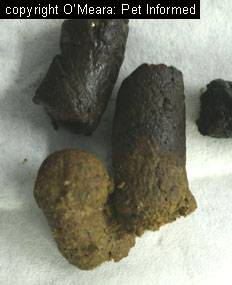 Parvo is shed into the environment in the feces of infected dogs. These dogs might be clinically affected with parvo (i.e. sick dogs with vomiting and diarrhea) or they might be non-clinical shedders of the virus (dogs that look normal, but which have nasty, replicating parvo viruses in their intestines and are passing infective particles into their stools). It is important to note that some vaccines, although they prevent a dog from becoming 'sick' with parvo, do not prevent the same animal from developing a carrier state and being at risk to other pets.
Parvo is shed into the environment in the feces of infected dogs. These dogs might be clinically affected with parvo (i.e. sick dogs with vomiting and diarrhea) or they might be non-clinical shedders of the virus (dogs that look normal, but which have nasty, replicating parvo viruses in their intestines and are passing infective particles into their stools). It is important to note that some vaccines, although they prevent a dog from becoming 'sick' with parvo, do not prevent the same animal from developing a carrier state and being at risk to other pets.
Animals become sick when they ingest the feces of affected sick or carrier dogs which contain infective virus particles. This is one of the many reasons why dogs should not be allowed to eat the stools (feces) of other animals.
Dogs can also ingest infectious particles when they lick the shoes, hands or clothes of a human that has been in hands-on contact with an affected animal. Those hands and clothes may look clean and may have even been washed, but parvo might still be alive on them. Biting and licking the fur of infected animals may also result in infection. Animals spread virus particles onto their fur through rolling or lying in feces or through licking their feces and then licking their bodies (virus from the tongue is transferred through the coat).
Importantly, it must be noted that parvo is an extremely long-lasting, difficult to kill organism. It is resistant to heat, cold, and most disinfectants. It remains infective for over 5 months and may last years. Consequently, wherever there has been parvo feces in the past (indoors or outdoors), there is likely to still be parvovirus in the environment. Just because you can't see any droppings does not mean that the surfaces: pavement, concrete, lawn, cages, food bowls, grooming equipment, ground or vegetation are not infective to your dog. The unvaccinated puppy that you have just taken to the park could walk across contaminated ground and come home, lick its feet, and get infected.
Obviously, some environments are more risky than others. Environments that are likely to have had parvo in the past (and are thus at higher risk of containing infectious particles) include pet shops, breeding facilities, puppy 'farms', grooming facilities, dog shows, dog clubs and, ahem, vet clinics. Parvo is a huge concern when it gets into a vet clinic, breeding facility or pet shop because so many young, under vaccinated puppies go through these places. Although these facilities, veterinary clinics in particular, disinfect their premises top to tail with parvo-killing chemicals every time a parvo case appears, you as the owner of a young dog should protect your puppy wherever possible by keeping him out of contact with surfaces (e.g. flooring) in these facilities. If you have a large breed puppy to take to the vet (large breeds may be impossible to keep off the floor), you can reduce your risk of parvo exposure by using the 'cat entry' side of the clinic (a lot of newer clinics have a cat side and a dog side).
Basic message:
Treat ALL environments as possibly parvo contaminated and keep your puppy out of contact with them until s/he is fully vaccinated.

4. What does parvo do to the dog - an overview of parvo symptoms?
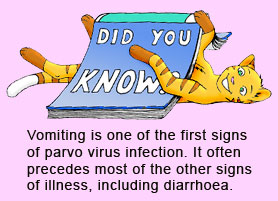 As mentioned in the opening sentences, parvo causes bloody diarrhea, vomiting, abdominal pain, dehydration, shock and severe illness in dogs affected with it. The following discussion is mostly for those of you who are interested in how the viruses works in order to create these parvo symptoms. Understanding how the virus works is useful because it aids your understanding of why certain treatments are required and why treating parvo is so darn expensive!
As mentioned in the opening sentences, parvo causes bloody diarrhea, vomiting, abdominal pain, dehydration, shock and severe illness in dogs affected with it. The following discussion is mostly for those of you who are interested in how the viruses works in order to create these parvo symptoms. Understanding how the virus works is useful because it aids your understanding of why certain treatments are required and why treating parvo is so darn expensive!
How a parvovirus works:
A parvovirus is a tiny organism (much smaller than a bacteria) which is made up of a shell or capsule (called a capsid) containing a strand of DNA. This DNA contains sequences that code for the replication of more strands of viral DNA; internal viral proteins and other virus components such as the virus capsid and surface proteins (the same ones we called antigens in our How Vaccines Work page) which allow the virus to access cells. Obviously, at a microscopic and chemical level, the parvovirus is more complicated than this, but for the purposes of easy understanding, this is pretty much what a parvo virus is.
Unlike bacteria and other, more advanced organisms, viruses do not contain all of the components needed to replicate by themselves. They require a host cell (e.g. a dog cell).
When the virus enters the body of a dog, it attaches to a particular cell-type that it has been specially 'designed' to invade (i.e. the virus has surface proteins that allow it to recognise, bind to and access certain cell types). For example, in parvo, the cells are intestinal cells and rapidly-dividing cells such as bone marrow cells; in kennel cough, the cells are cells of the dog respiratory tract. When the parvovirus attaches to a cell, a reaction occurs between the virus capsid and the cell membrane, resulting in a small passage being formed between the virus and the internal parts (cytoplasm) of the cell. The virus enters the cell through this passage. Once inside the cell, the virus capsid falls away, leaving the virus's DNA strand free in the cell interior and ready to do damage.
This viral DNA then enters the nucleus of the cell, the region of the cell that contains the cell DNA which is responsible for making the cell divide and responsible for coding for all of the proteins, sugars and fats that make the cell function normally (e.g. the proteins used in cellular chemical reactions, the proteins used to make the cell membrane, the proteins needed to get rid of unnecessary 'junk' that is made in the cell as a byproduct of its chemical reactions). The viral DNA enters the nucleus of the cell and makes use of the enzymes that the cell nucleus contains (and the virus lacks), which enable the DNA of the cell to replicate prior to cell division (the name of this enzyme is DNA-dependent RNA polymerase).
Using this borrowed enzyme, the virus replicates hundreds of copies of identical viral DNA sequences. It also uses the 'cell's machinery' (various cell enzymes and cellular organelles) to get the cell to create hundreds of new capsids and viral proteins. The new DNA copies get packaged into the newly created capsids, along with other viral elements that the cell body has produced and, viola, hundreds of new viruses are made. The cell dies as a result of the infection and bursts, releasing all of the newly-formed viruses into the gut and the body, where they then go and infect other cells.
The repeated process of virus invasion and cell destruction is what causes the disease in the animal. In the case of parvo, because the virus needs to make use of the nuclear enzyme used during cell division, it tends to replicate best in rapidly-dividing cell populations where levels of this enzyme are highest (consequently the viral damage tends to occur most severely and noticeably in rapidly-dividing cell populations). These rapidly-dividing cells are predominantly found in the intestinal 'crypts' (explained next) and in the bone marrow and lymphatic tissues (thymus, lymph nodes) of the animal: thus, most of the clinical signs relate to these organs. Virus particles can, however, potentially infect any organ, including the fetus, heart, brain and skin, and the impact of infection within some of these sites is discussed in section 7: severe complications of parvo infection. The symptoms of disease are seen when large numbers of cells start dying as a result of this viral replication.
Effects on the intestine:
The lining of the dog small intestine is not smooth, but is instead raised up into millions of small 'fingers' called villi (microscopically, the intestinal lining looks like a shag pile carpet!). These villi act to increase the surface area of the intestine over which the animal absorbs nutrients from its food.
The cells that form the villi originate in the 'valleys' at the base of the villi (these valleys are termed crypts). Cells divide and mature in the crypts before migrating outwards to form the villi. It is like a conveyor-belt, with youngest cells being those closest to the crypts (recently created cells) and oldest cells being those near the tips of the villi (old cells die and drop off the end of the villi and get digested or lost in the feces).
Parvovirus, because of its preference for rapidly-dividing cells, replicates in the dividing cells that form the crypts. During viral replication, these dividing cells are destroyed. They disintegrate and fall away from the intestinal wall, resulting in ulceration and bleeding. Without newly-made cells to replace them, the cells lining the villi eventually die off and fall away too. Without these surface intestinal cells to protect them, the internal tissues (connective tissues, blood vessels etc) of the villi are exposed to the chemicals and digestive enzymes of the intestine. Eventually the villi are destroyed, leaving the intestine smooth (not raised into fingers).
Bleeding and dehydration:
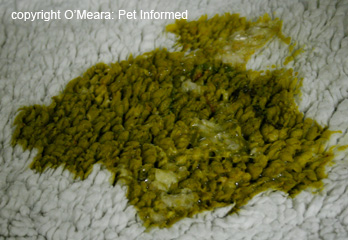 The loss of the lining cells of the crypts and the villi results in ulceration and extensive bleeding of the intestinal wall. This is why we see lots of blood in the feces and vomit as the disease progresses. The severe, diffuse injury of the intestinal lining results in massive inflammation of the gut: the intestine becomes swollen and paralysed (unable to move) and a condition called ileus (non-moving gut) occurs, which results in vomiting and an inability to keep any food or fluids down. The bleeding and the massive inflammatory response that occurs in the intestines, results in enormous loss of water and body-proteins into the intestines (these are lost in the diarrhea and vomit), a loss that is further compounded by the fact that the animal can not keep any water or food down (due to vomiting) and the fact that the nutrient-absorbing cell-lining and villi have been lost (there are no cells or absorptive 'fingers' left to absorb any food that does make it to the gut). The result is massive loss of body proteins (albumin, in particular) and massive dehydration, which, if left untreated, will lead to shock and death.
The loss of the lining cells of the crypts and the villi results in ulceration and extensive bleeding of the intestinal wall. This is why we see lots of blood in the feces and vomit as the disease progresses. The severe, diffuse injury of the intestinal lining results in massive inflammation of the gut: the intestine becomes swollen and paralysed (unable to move) and a condition called ileus (non-moving gut) occurs, which results in vomiting and an inability to keep any food or fluids down. The bleeding and the massive inflammatory response that occurs in the intestines, results in enormous loss of water and body-proteins into the intestines (these are lost in the diarrhea and vomit), a loss that is further compounded by the fact that the animal can not keep any water or food down (due to vomiting) and the fact that the nutrient-absorbing cell-lining and villi have been lost (there are no cells or absorptive 'fingers' left to absorb any food that does make it to the gut). The result is massive loss of body proteins (albumin, in particular) and massive dehydration, which, if left untreated, will lead to shock and death.
Bacterial invasion into the blood and tissues:
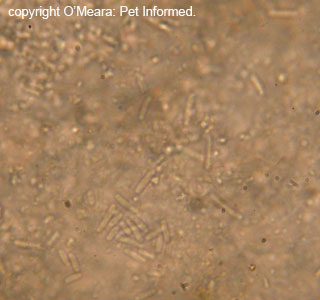 The ulceration of the intestine allows bacteria normally present in the gut to enter the blood stream. These bacterial levels in the small intestine can be very high because the gut is not moving (movement of the gut is a normal mechanism by which excessive populations of bacteria get cleared from intestine through the feces). If the gut does not move, bacteria will just brew away in the unmoving regions of the gut, their populations expanding to massive levels. Bacteria infection of the blood (termed bacteremia, septicemia or blood poisoning) is very nasty, resulting in extensive inflammation and damage to many blood vessels and organs (e.g. lung, kidney) and severe septic shock (which can often be fatal).
The ulceration of the intestine allows bacteria normally present in the gut to enter the blood stream. These bacterial levels in the small intestine can be very high because the gut is not moving (movement of the gut is a normal mechanism by which excessive populations of bacteria get cleared from intestine through the feces). If the gut does not move, bacteria will just brew away in the unmoving regions of the gut, their populations expanding to massive levels. Bacteria infection of the blood (termed bacteremia, septicemia or blood poisoning) is very nasty, resulting in extensive inflammation and damage to many blood vessels and organs (e.g. lung, kidney) and severe septic shock (which can often be fatal).
Bacteria can become deposited into the small capillaries of the joints, eyes, heart and kidneys, leading to infection of theses places. Septic arthritis (bacteria in the joints), in particular, is a well-known complication of parvo in puppies.
Intussusception:
An additional note: spasming and thickening of the intestine during parvo virus infection can result in the gut telescoping into itself and a complication caused intussusception. Correction of this complication requires surgery: surgery that is likely to be done on an already malnourished, possible septic and compromised animal. Not good.
Effects on the bone marrow and lymphatic-tissues:
The rapidly-dividing cells that exist in the bone marrow and lymphatic tissues (lymph nodes, thymus etc.)
and which go on to create all of the major white blood cell types responsible for fighting disease in the body are preferentially targeted and destroyed by parvoviruses. The result is a lack of circulating white blood cells in the blood, a condition termed panleukopenia (where feline parvo gets its name: feline panleukopenia).
Pan = all
Leuko = white (as in white blood cells)
Penia = means 'lack of'
So, in other words, a lack of all white blood cells.
The lack of white blood cells means that there are few cells available to fight the virus and the secondary bacterial infections that can result. The consequence of this can be overwhelming infection and it is one of the major reasons why animals with parvo are so sick and why they need so many intravenous antibiotics and why so many end up dying. With other nasty gastrointestinal diseases such as canine coronavirus and bacterial enteritis, there does not seem to be such a profound suppression of the immune system white blood cells and this is probably why, although unwell, more of those animals survive.
Minimal or absent clinical signs:
It is possible for some puppies and dogs to be exposed to wild-type, parvovirus strains and to show only mild gastrointestinal signs or no clinical signs at all. These mildly affected animals will usually survive and they will either clear the virus from their intestines or become carriers of the virus (these animals shed infectious viral particles into the environment).
The reason parvovirus infection might only be mild could be due to the strain of virus encountered in the environment, a very low dose of viral particles being ingested or the animal having some degree of immunity (e.g. maternal immunity, immunity from previous vaccine virus or wild-type virus exposure).

5. Diagnosis of parvovirus: How do we diagnose parvo?
Canine parvovirus is generally diagnosed in vet clinics using one of a range of in-house ELISA type test kits, which are commercially available. In most of these tests, a swab of feces is taken from the dog's rectum and run through the test kit in order to see if the sample of poo contains parvo virus antigens (proteins on the surface of the virus capsid that are specific to parvoviruses).
How does the parvovirus test work?
The reactive area of the parvovirus test kit (the bit that should come up positive in the presence of viral antigens) is coated with anti-parvovirus-antibodies These antibodies lining this region of the test kit are the same antibodies as those made in an animal's body when it has been vaccinated against parvo (antibodies are protein defenses made by the immune cells in order to recognise and defend the body against a specific viral antigen). For a great explanation of antibodies: how they are created and what they do, visit our see our How Vaccination Works page.
The viral antigens in the fecal sample bind to the parvo-specific antibodies lining the parvo test kit and a chemical reaction occurs resulting in the formation of a blue dye. This is how we can tell, from looking at the test, that the result is parvo positive.
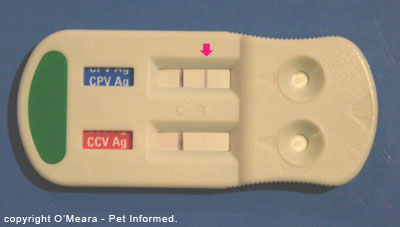
Can a dog test positive to parvo and not have parvo?
Yes: these results are termed false positive results. It tends to occur when animals are tested that have been vaccinated 4-14 days beforehand. When an animal is vaccinated with a live vaccine parvovirus, this vaccine parvovirus replicates in the cells of the dog's intestines, similar to that which occurs in real parvo infection (the vaccine virus just doesn't cause obvious disease). Replicated vaccine virus particles (whose antigens mimic those of the real virus) enter the feces and will be detected as a positive on the parvo ELISA test. Thus, an animal that is vaccinated and protected against parvo will appear to have been infected with the disease.
Can a dog test negative for parvo and have the disease?
Yes: These results are termed false negative results. They tend to occur for two main reasons:
- the disease process is very early. It takes time (about 4 days) for virus particles to replicate and to start shedding into the feces where they can be detected on parvo testing kits.
- the antibody response of the animal is very high. This tends to occur later in disease. If an animal does not die, infection with parvo will eventually result in a response from the immune system: the immune system will mobilise defensive cells and produce antibodies to try to kill the virus. Many of these antibodies will remain in the bloodstream, but many will also be secreted into the intestinal tract (antibodies are one of the proteins that leak into the gut through the inflamed, ulcerated zones). These antibodies will bind to viral antigens in the feces and this can 'block' the antibodies in the parvo test kit from getting exposure to them. The result is a false negative.

6. Canine Parvo Virus Treatment Options:
Treatment of canine parvovirus is pretty much a treatment of symptoms. We know that the disease is caused by a virus, however, we are unable to treat the virus itself per se because no antiviral remedy has been produced or made available in any mainstream capacity to kill it. Treatment, therefore, revolves around treating problems and symptoms as they come. The treatment options for parvovirus, their mechanism of action and their pros and cons are discussed below.
1a) Intravenous fluids.
If animals have severe vomiting and diarrhea and are pouring massive amounts of inflammatory and intestinal-secretory fluid out into their bowel, then they are going to dehydrate pretty fast. Puppies with parvo almost always need intravenous fluids.
Sometimes, puppies come into the vet which are so collapsed and dehydrated (severe shock signs) the veterinarian can't get an intravenous catheter into them. In these cases, the vet will sometimes put a catheter into the jugular (large vein in the neck) or put a needle into the bone of the thigh (femur) or upper arm (humerus) to administer fluids. Don't be alarmed to see your vet do this: they are perfectly acceptable ways of giving fluids to animals in severe shock.
Often the vomiting and diarrhea are associated with severe loss of blood salts (called electrolytes) into the intestines and these will need to placed in the fluids given to the puppy. Glucose levels can also become very low in puppies with parvo (glucose is used up by multiplying bacteria and by the inflammatory cells that come in to treat disease) and so glucose will need to be added to the fluids to keep the levels normal.
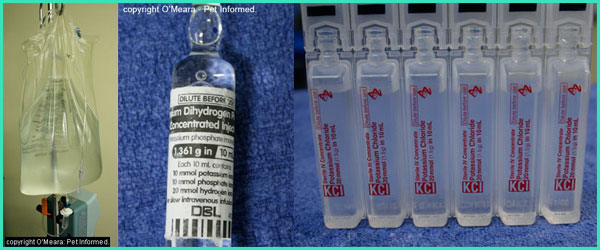
1b) Special intravenous fluids - colloids:
When dogs lose excessive amounts of protein into the intestine, their blood levels of a protein called albumin can plummet. This protein is responsible for many actions within the body, one of the most important being the maintenance of colloid-oncotic pressure (COP). Put basically, COP is a force exerted by blood salts and proteins, such as albumin, that keeps the fluid present in blood (plasma) within the blood vessels. Without this force, the fluid would leak out of the blood vessels, resulting in a severely low blood pressure (not enough blood for the organs) and infiltration of fluids into areas where they are not wanted (e.g. the lung and the brain!)
When albumin is lost during parvovirus infections, there is a risk of colloid-osmotic pressure falling. Veterinarians treat this situation by either:
1) giving special synthetic fluids which contain products that mimic the COP effects of albumin (these special fluids are termed colloids) or
2) replacing the lost albumin with real albumin - a plasma transfusion (see next section).
Colloids can also be used in puppies that come in with severe signs of shock and low blood pressure. Because they act to increase the colloid oncotic pressure, they can draw fluids from other areas of the body into the blood vessels, thereby boosting blood pressure while the animal is being properly hydrated with other fluids.
Colloids are great products, but don't come without risks. They are artificial synthetic substances and, as such, have the potential to cause allergic and anaphylactic reactions in patients given them. They also have the potential to induce bleeding problems in animals with low blood platelets and can cause blood pressure to become too high.
1c) Special intravenous fluids - plasma:
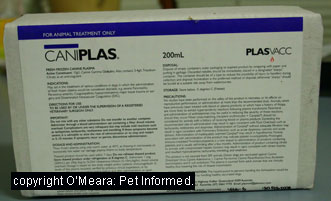 Plasma is the fluid left when you remove all of the cells from blood. It contains loads of really helpful substances that can really make a huge difference to the survival chances of parvo puppies.
Plasma is the fluid left when you remove all of the cells from blood. It contains loads of really helpful substances that can really make a huge difference to the survival chances of parvo puppies.
These include:
1) albumin - as mentioned before, albumin is responsible for maintaining colloid oncotic pressure within the blood of the puppies so that their blood vessels don't start leaking. Albumin is also responsible for many other functions within the body, including the transport of some antibiotics and therapeutic drugs.
2) immune-modulatory proteins (e.g. some inflammatory proteins) - these assist the body in generating an effective immune response.
3) antibodies - since many canine blood and plasma donors have been vaccinated against parvovirus, their blood often contains anti-parvo antibodies. When these antibodies are transfused into sick puppies, they help to fight the parvo infection. The effect is similar to the antibody protective response that we want to occur when the animal is sufficiently vaccinated.
4) proteins that mediate coagulation - Some severely affected animals can get disorders of their blood clotting mechanisms: a problem termed DIC (see section 7 - complications of parvo). The animal's blood either wants to clot excessively, leading to emboli and 'strokes'; or it does not want to clot at all, leading to excessive bleeding. Plasma is required to treat this complication.
Plasma is more expensive than synthetic colloids, however it contains many more helpful elements in it than the synthetic colloids do. If you can afford it, a plasma infusion is strongly recommended for puppies with parvo infection.
Also note that plasma, like the synthetic colloids, is not without risk. It is a proteinaceous substance being given intravenously. Thus, in some patients, there is the possibility that it could cause allergic or anaphylactic reactions.
1d) Special intravenous fluids - blood:
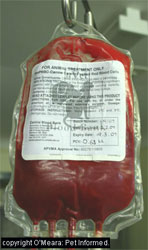 Some patients lose so much blood as a result of gastrointestinal ulceration that they can actually become severely anemic in addition to losing protein into the gut.
Some patients lose so much blood as a result of gastrointestinal ulceration that they can actually become severely anemic in addition to losing protein into the gut.
These patients may need a blood transfusion (contains red blood cells) to replace those red blood cells lost into the gut. If whole, fresh blood is available (blood taken freshly from a donor) this can be particularly helpful. Freshly-drawn, whole blood contains live white blood cells (in parvo dogs that have low white blood cell counts, these might be of some help in fighting infection) and also plasma antibodies and albumin.
2) Antibiotics.
As mentioned before, these animals are at huge risk of overwhelming infection. Not only is their gut ulcerated and non-motile (letting lots of bacteria into the blood), but their white blood cell counts are low, reducing their ability to fight infection. Broad spectrum, bactericidal (antibiotics that actually kill bacteria, not just suppress it) intravenous antibiotics are a key element of parvo virus treatment.
Commonly used antibiotics include:
Intravenous third generation cephalosporins.
Intravenous ticarcillin/clavulanic acid (e.g. Timentin).
Intravenous fluoroquinolones - enrofloxacin, ciprofloxacin etc. Note that these are considered contraindicated in pups under 12 months old (18 months for big breeds) because of effects of growing cartilage, however, these pups are really sick and it may be vital to use these antibiotics if we are to save them.
Intravenous aminoglycosides - e.g. gentamicin. These are known to be toxic to the kidneys and should not be used in dehydrated animals (i.e the hydration needs to be achieved first). They are less toxic if given as a higher, once-a-day dose than as a lower, many-times-a-day dose.
Intravenous metronidazole.
These antibiotics are often used in combination to achieve broad spectrum. Timentin with enrofloxacin is a nice-broad spectrum combination, as is Timentin with gentamicin.
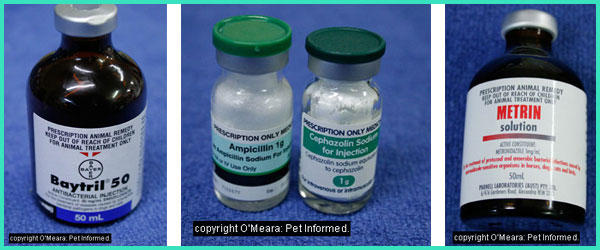
3) Anti-emetics (drugs that stop dogs vomiting).
Anti-emetic drugs are often used to make puppies feel better (it must be terrible vomiting all the time), to reduce the loss of fluids through repeated vomiting and to get the gut moving again (many work by making the intestines mobile again).
They are best given as continuous rate infusions (i.e. given in a constantly-running drip) rather than frequent injections.
4) Pain relief.
Severe ulceration of the gut and abdominal pain is one of the many parvovirus symptoms, which must be managed. Pain relief must be given to these puppies with parvovirus to make them more comfortable.
Generally injectable, opiate drugs (e.g. methadone, fentanyl) are used in these animals to achieve pain control. Oral medications are not kept down. Drugs such as non-steroidals (e.g. carprofen, meloxicam, tolfedine) and corticosteroids (prednisolone, dexamethasone, triamcinolone) are contraindicated in animals with severe, ulcerative intestinal disease.
Because the intestine of these puppies does not move, their stomachs can fill with large amounts of fluid. This bloating and abdominal distension is painful. Simply passing a tube into the puppy's stomach (via the mouth) to release the fluid can relieve this discomfort.
Skin scalding around the anus of puppies with diarrhea is also very painful. The scalding can be reduced by applying waterproof, soothing creams to the perineal skin (skin around and under the anus). Useful creams include vasoline (petroleum jelly) etc.
Ulcer medications (next section) can also act to soothe the pain of intestinal ulceration.
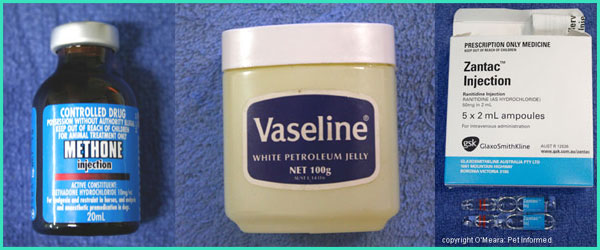
5) Ulcer medications:
Injectable medications are often used to reduce gastric acid production by the stomach in order to reduce the pain of these acids burning on the ulcerated intestine. They have limited effect, but are useful.
Of those that are readily available in most clinics as part of parvo treatment, intravenous omeprazole is probably the most effective (it is costly, though), followed by the H2-blockers (ranitidine and cimetidine).
Oral antacids and ulcer-coating drugs can be given to animals that can tolerate oral medications (e.g. carafate).
6) Warmth:
Animals that are cold or in shock require warming to normalise their body temperatures. Provision of warmth may be as simple as providing the puppy with warm bedding or a heat pad or it may require extra measures, such as warming the fluid lines, bubble-wrapping the feet and using specialised warming equipment, such as the bear-hugger.
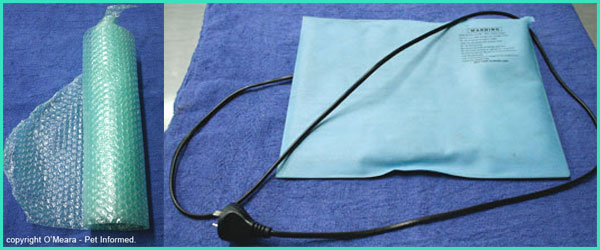
Monitoring:
Monitoring a severely-affected, septic parvo puppy involves an extremely high level of intensive care work. These animals are about as ill as you can get and their status can change hour to hour: ideally these puppies need 24 hour attention.
Monitoring of these pets varies according to the equipment and expertise of the vets and according to the status and severity of the puppy, but generally it includes:
- regular examinations - checking heart rate, lung sounds, temperature etc.
- regular care of IV lines and catheters
- regular blood pressure measurements.
- urine monitoring.
- regular treatments (those listed above) and treatment adjustments and
- regular blood testing.
During their stay in hospital, parvo puppies often require lots of blood testing to monitor their levels of hydration, electrolytes, glucose, proteins, red and white blood cells and organ function. Many of these tests will be performed several times a day and treatment and prognosis adjusted according to the results gathered. Trends over time (a series of measures) are particularly helpful as they can give veterinarians and their owners some idea of prognosis.

The trouble with such intensive monitoring is that, not only does the poor puppy have to get bled several times a day to get the samples, but the repeated lab-work is also expensive for their owners. We talk about costs in section 8.

7. Possible severe complications of parvovirus infection:
1) Intussusception:
Spasming and thickening of the intestine as a result of parvovirus infection can result in the intestine telescoping into itself. Diagnosed by abdominal palpation and confirmed on ultrasound, intussusception can be acutely life-threatening because the telescoped bowel can strangulate and die or it can adhere in this position (i.e. become unable to be straightened out), requiring the surgeon to surgically remove long lengths of bowel to fix it. Treatment is surgical.
2) Infected joints or other regions of the body:
Bacteria that enter the bloodstream can deposit in the small capillaries of the joints, eyes, heart and kidneys, leading to infection and even abscesses within theses places. Depending upon where they 'seed' these infections can be very damaging to organs and joints and very difficult to remove and cure once they have set in. Infections such as bacterial endocarditis (infection of the heart valves) can be fatal and infections of vital organs such as the kidneys can result in renal failure. Septic arthritis (bacteria in the joints), is a well-known complication of parvovirus and treatment of it involves surgically opening the affected joints; flushing them out and placing long-acting antibiotic beads in them. This can involve many visits to the vet and many repeat surgeries.
3) Parvoviral myocarditis (damage to the heart caused by parvo) :
In young puppies (usually under 6 months) the parvo virus can sometimes attack and damage the muscle of the heart directly. These puppies may be infected with parvo in utero (see next section) or after birth. This can result in sudden death or progressive signs of congestive heart failure and may occur with or without obvious signs of gastrointestinal disease. The dog could even seem to recover from its gastrointestinal infection (e.g. recover from the hemorrhagic diarrhoea) and then, in the months after parvo infection, come down with heart failure.
4) Fetal parvovirus:
If an unvaccinated female dog is inadvertently vaccinated with a live parvo inoculation (vaccine) or infected with parvovirus disease during pregnancy, the virus (wild-type virus or vaccine virus) may be able to infect her unborn puppies. The virus could infect any rapidly dividing cells in the fetus, causing a number of fetal abnormalities or even death of the fetus, but in particular, the virus is known for infecting the fetal brain and heart. The virus (live vaccine virus or wild-type virus) can destroy certain cells of the developing cerebellum, resulting in puppies being born with poor cerebellar function and intention tremors (the puppies tremor when they try to move) of varying severity. The virus may also damage the heart, causing death in utero (in the uterus), death soon after birth or progressive congestive heart failure (signs include: coughing, fluid on the lungs, difficulty breathing).
5) Sudden death:
Parvo animals, even those that seem to be recovering from their disease, can suddenly 'drop dead'. This may be due to a blood clot being thrown into the lungs, brain or heart (septic parvo dogs are prone to hypercoagulation - excessive clotting of the blood), complications of severe, overwhelming bacterial infection or myocarditis (see point 3).
6) DIC - disseminated intravascular coagulopathy:
This is a severe, life-threatening complication of parvovirus and is generally associated with severe bacterial infection (sepsis) of the blood. It is a complicated disease process, but put basically, the bacteria and their toxins cause injuries to the lining of the blood vessels all over the body. The body responds by trying to clot all of these blood vessel defects: the excessive coagulation response can lead to blood clots being thrown around the body which can result in sudden death (see point 5) or severe injury to organs (e.g. kidneys, brain). Eventually, the body runs out of clotting factors and is unable to repair the blood vessel defects made by the bacteria: this results in an animal with an inability to clot its blood - a bleeding problem results and the animal shows excessive bruising and hemorrhage. Many puppies that get DIC will die.
7) Multiple organ damage and failure:
Parvo animals that are in severe shock or that are severely septic (lots of bacteria, bacterial toxins and inflammatory proteins in the blood and organs) are at risk of multiple organ damage. Organs can be injured as a result of many complicating factors including:
- blood clots: clots can block blood vessels supplying nutrients to organs
- low blood pressure: severe dehydration will drop blood pressure due to a lack of water in the body and vessels. Also, blood vessels will often dilate uncontrollably in severe systemic inflammation (systemic inflammation - an inflammatory response that involves the entire body - can occur when bacteria enter the blood or when organs and blood vessels start to disintegrate) and overall, this dilation of vessels drops the blood pressure and the supply of oxygen and nutrients to the tissues
- certain drugs: some drugs and antibiotics will injure organs
- bacterial injury: bacterial populations can enter organs and cause direct injury.
The kidneys, lungs and brain are most at risk of injury as a result of these processes. The signs can be:
- failure of urine production: animals will stop making urine and stop clearing toxins from their bodies.
- fluid entering the lungs: small holes in the blood vessels and/or a severe drop in albumin (see colloid oncotic pressure in fluids section of part 6: treatment) allow fluid to enter the lung spaces. This condition (termed acute respiratory distress syndrome or ARDS) stops the lung from taking in oxygen and the animal effectively drowns.
- neurological signs: seizures, severe mental depression etc.
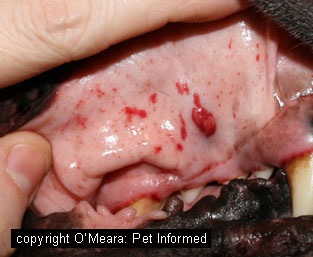
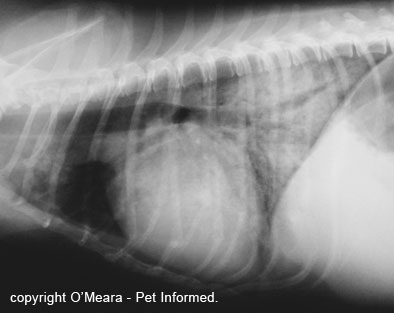

8. The price of treating a parvo puppy.
Parvovirus is one of the more expensive infectious diseases that we, as veterinarians, treat. Obviously the cost varies depending on the severity of the animal, however, in Australia, where I come from, it would be very rare to treat a moderate-badly affected case of parvo for under $1000. Once you start talking 24-hour care and blood and plasma transfusions and all of the expensive antibiotics, $2000-upwards would be fairly normal (in some places even this would be considered a gross underestimation).
Add some of the parvo complications (surgery on an intussusception or septic joints) to this and you start getting into quite high figures.
Some of the reasons why it can be so expensive to treat a parvo case:
1) These animals require a lot of work - repeated blood testing, lots of drugs, lots of one-on-one care. They are proper intensive care cases.
2) These animals are kept in isolation - running an isolation area in a vet clinic requires that all manner of extra measures and precautions be taken in order to prevent the disease from spreading around the rest of the clinic: gloves, gowns, foot-baths, disinfectants ... some places even have their own, private isolation ward.
3) Some of these animals require treatment in a 24-hour facility - the costs of having an animal cared-for in a day-night-service can be significantly higher than the costs incurred in day-only practice situation.
4) Many complications can occur, which need to be treated as they appear.
The financial woes of parvo puppy owners are further compounded by the fact that this expensive condition is not usually covered by pet insurance companies. Canine enteritis is a vaccine-preventable disease and therefore not covered.
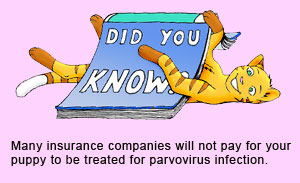 The reason I have included a piece on the costs of parvo therapy is not to discourage you from treating parvo, but to make you well-informed of what is entailed. The moderate to severe cases are often very expensive and not for the financially faint-hearted. They aren't the kind of cases that can generally be managed by trying a couple of small, inexpensive measures, just to 'see if it works': in my experience, these pups tend to deteriorate quickly and sometimes unexpectedly. In my opinion, severe parvo cases are "all-in or not-in" cases: you either get them treated properly (understanding everything that this intensity of treatment might entail) or be prepared to end up with a very expensive, deceased puppy. Remember that, even if your puppy is treated with the very best treatment money can buy (thousands of dollars-worth in some cases), many of these puppies are simply too unwell and weak and young to survive.
The reason I have included a piece on the costs of parvo therapy is not to discourage you from treating parvo, but to make you well-informed of what is entailed. The moderate to severe cases are often very expensive and not for the financially faint-hearted. They aren't the kind of cases that can generally be managed by trying a couple of small, inexpensive measures, just to 'see if it works': in my experience, these pups tend to deteriorate quickly and sometimes unexpectedly. In my opinion, severe parvo cases are "all-in or not-in" cases: you either get them treated properly (understanding everything that this intensity of treatment might entail) or be prepared to end up with a very expensive, deceased puppy. Remember that, even if your puppy is treated with the very best treatment money can buy (thousands of dollars-worth in some cases), many of these puppies are simply too unwell and weak and young to survive.
For those of you that are forced to make the ultimate hard decision (regardless of whether this is a financial decision or not); there is no shame in euthanasing a puppy that has come down with severe parvovirus. Parvo is one of the more deadly diseases to afflict our canine population and it is no walk-in-the-park to manage.

9. Prognosis for parvo virus:
Due to the severe complications (sepsis, heart disease, shock) that can occur as a result of parvo infection and the often markedly undernourished, underweight and immunocompromised status of many of these patients, there can be no guarantee that any one puppy affected with parvovirus will survive. Regardless of the care given and the thousands of dollars spent, affected puppies may simply not survive.
Some findings have been found to be associated with a poorer outcome and they include:
1) severe leukopenia (lack of white blood cells) - the animal can not fight the overwhelming infections
2) very young puppies (birth to around 10 weeks)
3) rottweilers - many vets, including myself, have found clinically that rottweilers do not seem to cope as well with certain severe illnesses including parvo.
Obviously the presence of severe complications - myocarditis, DIC, severe sepsis (bacteria in blood), septic shock and multiple organ failure - reduces a young animal's chances of survival.

10) How to prevent parvo - hints for the typical dog owner.
Hopefully, the above discussions about clinical parvo disease should have made it very clear to you how important it is that puppies be prevented from getting infected with parvo in the first place. Prevention entails several key principles: immunization; avoiding contact with contaminated environments and enhancing the health, body condition and immunity of the animal.
1: Vaccinating against parvo virus.
Parvo is one of the five core vaccine viruses used in almost all puppy vaccines. Typically normal, healthy puppies receive live attenuated virus vaccines for their first and subsequent vaccinations: these vaccines promote better and longer-lasting immunity (see our how vaccines work page for information on live versus killed vaccines).
Vaccination against parvo typically begins with a first needle that is administered at 6-8 weeks of age, however vaccination may start earlier if the puppy is in a very high-risk parvo area (see section 11: high risk parvo situations) or, in rare situations, later if the puppy is unable to have the 6-8 week vaccine for health reasons (your vet will notify you if this is the case).
Following the 6-8 week vaccine, your puppy will require follow-up boosters. The protocol for these follow up boosters differs depending on the type and brand of vaccine used by your vet and the manufacturers' recommendations: your vet will notify you of when the next vaccinations are due.
The original conventional vaccine brands put out by vaccine companies (and still commonly used) typically advised puppy vaccinations at 6-8 weeks, 12-14 weeks and 16-18 weeks (basically, three injections approximately one month apart). Vets also tended to give an additional 20 week parvo-only vaccine to black and tan dogs that were considered parvo-sensitive. The reason for the (comparatively) long course of puppy shots was the issue of maternal immunity and the fear that, if puppies were not vaccinated at 16-18 weeks, their maternal antibodies might have 'killed off' the previous vaccinations and thereby prevented the puppy from gaining its own protective immunity. See our vaccinating the pregnant bitch page for details on maternal immunity.
More recently, potentiated vaccines have been brought out that stimulate a greater immune response, overcome maternal immunity and allow for the vaccine course to be completed earlier (by 12 weeks), thereby allowing earlier socialization. Vaccines include Fort Dodge's Protech Duramune vaccines. The vaccine guidelines for these vaccines typically advise a 6 week vaccine, 9 week vaccine and a 12 week vaccine or (if the first vaccination was an 9 week vaccine), a 9 week and a 12 week vaccine. A couple of the very new potentiated vaccines (e.g. Intervet's Nobivac DHP and Fort Dodge's DuramuneAdult C3) even advocate a 6 week, 8 week and 10 week vaccine or (if the first vaccine is given at 8 weeks), an 8 week and 10 week vaccine, with full protection for a year conferred within a week after the final parvo vaccine (e.g. 10 weeks in this case) has been given.
The newer potentiated vaccine types also feature 'one-shot protection' in that full immunity (12 months minimum) can be attained with a single parvo vaccination if the vaccine is given at or after 12 weeks (for the 12-week finish types) or if the vaccine is given at or after 10 weeks (for the even newer 10-week finish types). This is a great feature, but owners should not wait until 10 or 12 weeks has passed before getting their puppy their first parvo vaccine because they will unprotected until that time.
Following the course of puppy vaccines, your dog will need to receive a parvo booster annually to remain fully protected. Newer vaccines such as Intervet's Nobivac DHP and Fort Dodge's DuramuneAdult C3 confer immunity against parvovirus for three years.
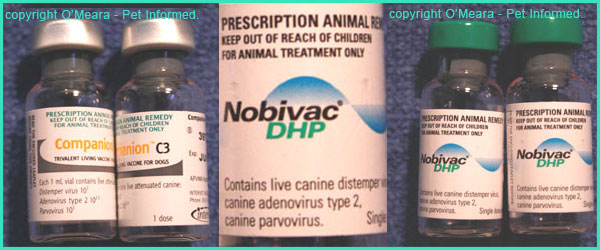
Does brand of vaccine matter?
Obviously if you are looking to socialize your puppy as early as possible (and most people are), then a potentiated vaccine that induces full protection by 10 or 12 weeks is much more desirable.
As far as the strain of virus used in the individual vaccine brands goes, it should be mentioned that the strain of live parvovirus used in the vaccines rarely ever seems to be an issue (at least, in Australia) with regard to the effectivity of the vaccines. Most vaccines seem to include all that they need to in order to prevent parvovirus from occurring in most populations of dogs (after all, it is still rare to see cases of clinical parvovirus in vaccinated animals). This is supported by some textbooks (e.g. Greene CE) which state that the parvo virus strains used in the vaccines are very rarely ever associated with vaccine failure in dogs and that it is more likely to be inference of strong maternal antibody levels or lack of appropriate immune response
to vaccination which are responsible for vaccination failure. Consequently, any live parvovirus vaccine that your vet administers should be perfectly adequate to prevent parvo in your pet.
Outbreaks of parvo do, however, occasionally occur in vaccinated dog populations. Given that these animals (which often come from close regional locations) should not have all had issues of conflicting maternal immunity or a failure of immune response, one would surmise that such outbreaks must be due, in part, to the appearance of a different strain of parvo that the vaccines used are not protecting against (typically the CPV-2b strain is one credited for this occurrence). If such outbreaks have been occurring in your local or regional area (your veterinarian will, no doubt, know of this from all of the cases of parvo s/he has been getting in) then choice of vaccine brand may need to be considered more carefully, making sure that the vaccine chosen does cover for the strains of parvo that are occurring in your local region.
Over very recent years, Fort Dodge has brought out a range of potentiated Duramune vaccines which do include cover against the CPV-2b strain of parvovirus. This parvovirus vaccine should induce a better immune response towards the 2b strain than vaccines which comprise of the CPV-2 strain only.
2: Avoid contact with contaminated environments:
As stated in section 3 (Where do animals catch parvo from), anywhere that dogs have been (parks, vet clinics, grooming salons, dog shows) could potentially harbour infectious parvoviral organisms. Consequently, your puppy should not be taken out of your home, into the public arena and put into contact with any potentially contaminated surfaces or other animals until he or she is fully vaccinated and your vet says it is safe to socialise.
Another potential risk to your unvaccinated puppy is bringing diseases home with you. If you have visited a place where there has been parvovirus infection (or any outbreak of infectious disease, for that matter), don't bring these diseases back to your house where your unprotected puppy can catch them! Change your clothes, disinfect your shoes (with parvo, this disinfection requires powerful chemical virucides like bleach) and shower thoroughly (this includes washing your hair) before greeting your pet. Ideally, disinfection should take place somewhere other than your own home. The same precautions should be taken when other people visit your home: ask them if they have had any potential contact with infectious diseases.
If you have had a case of parvo in your own home and/or yard, then you will need to disinfect these contaminated areas carefully in order to make them safe for any new puppies that you bring home in the future (see section below on parvovirus decontamination). If contamination has been severe or the chances of ridding infectious organisms from your home unlikely (e.g. getting parvo out of carpet might be tricky), then you should read section 11 (preventing parvo in high-risk situations) carefully as some of the tips apply to you.
Avoiding heavily contaminated environments is still advisable once your dog has been fully vaccinated. Once immunized, your pet can go to the show, the park, beach, groomer or pretty much anywhere else, however, I would still recommend avoiding areas where there has been recent infection and illness. Vaccinated dogs that get exposed to very heavy environmental levels of parvo virus particles can still catch the disease and become sick.
3: Enhancing the health, body condition and immunity of the animal.
A big part of parvo prevention involves the activities of a healthy, full-functioning immune system. Although vaccination is key to promoting the 'right type' of immune response, the overall health and wellbeing of the animal is critical if there is to be a strong immune system response to disease. Disease prevention (including parvo prevention) involves a holistic approach, with nutrition, exercise and mental health care all important parts of the process. Animals that are in good body condition and which have been given a balanced diet and are well-exercised and emotionally sound (e.g. not overly stressed or bored etc.) will generally be more resistant to disease and able to mount a better immune response.
Puppies that are malnourished and/or which harbour other bacterial and parasitic infections in their intestines are prone to more severe parvo infections. Thus, good nutrition and control of intestinal parasites (worming etc.) and harmful bacteria (Clostridia, Salmonella etc.) are important in preventing and reducing parvo severity.
- Puppies should be routinely wormed.
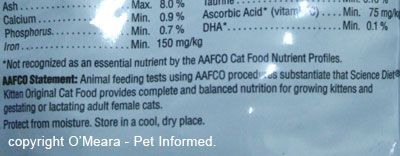 - Puppies should be fed a completely balanced (AAFCO approved) puppy diet.
- Puppies should be fed a completely balanced (AAFCO approved) puppy diet.
- Puppies should be played with and exercised within the home until fully vaccinated (this human contact fulfills their exercise and mental health needs).
- Dogs should be walked twice daily (once vaccinated) for a bare minimum of 15-30 minutes at a time to aid both their mental health (reduces boredom) and exercise needs.
- Dogs should have toys and adequate room to move (e.g. yard size) to reduce boredom and stress whilst you are at work.
- Dogs should not be overfed or allowed to become obese.
- Purchasing in-bred animals should be avoided - excessive inbreeding may result in appearance of genetic immune disorders.

11. Controlling parvovirus in high-risk and/or already contaminated environments.
There are many situations where the risk of young (and sometimes older) animals contracting parvo is above that of the rest of the population. Situations include: high-population dog breeding facilities that have had outbreaks of parvovirus recently or in the past (these facilities will often lose many new-born pups to parvo); businesses which admit many dogs and which have been confronted with a case of parvo (e.g. veterinary clinic, grooming salon, dog club, dog classes) and individual homes that have had a pet contract parvo and are wanting to make the place safe again for other dogs and new puppies.
Control of disease in these situations involves:
1) protecting the susceptible animals and preventing them from becoming infected and
2) reducing environmental contamination.
1: Protecting the susceptible animals.
In a situation of high parvovirus load in the environment, any unvaccinated, very young or very old or unwell animals are going to potentially be susceptible to infection from the parvoviral contamination that is present in the environment. In most cases, the susceptible animals are going to be very young or new born puppies. The risk of them contracting parvo can be reduced in the following ways (this is by all means not an exhaustive list):
1) Keep all females of breeding age up to date with vaccines.
Ensure that pregnant bitches are up to date with their vaccines so that they have some levels of maternal immunity (parvo antibodies) to pass onto their newborn puppies.
2) Consider vaccinating pregnant bitches.
Vaccinating pregnant bitches with killed parvo virus vaccines 2-3 weeks prior to birth will enhance anti-parvo maternal immunity. See our vaccinating the pregnant dog page for further details on enhancing maternal immunity and the risks entailed.
3) Isolate pregnant bitches and litters.
Isolate bitches in easy-to-disinfect (e.g. tiled or concrete areas, not grass or soil) pens, which have preferably never been contaminated with parvo, from the time of whelping to the time of weaning. If whelping bitches and pups can be removed to a new non-contaminated premises altogether, this is even better. All bedding should be new (or at least unused by another dog) and should be either strongly disinfected or, preferably, discarded after use by the bitch.
4) Ensure that puppies get their colostrum on time (<24 hours after birth).
Puppies must be monitored to ensure that they do get their colostrum (maternal immunity). Bitches that are recovering from caesarian section (unable to fed the pups yet) or that are initially reluctant to feed the pups for other reasons can be milked of their colostrum and this can be fed to them through bottle or stomach tubing.
If the bitch has no colostrum or leaks her colostrum early, plasma can be taken from the bitch and given to the puppies either orally in the milk (within the first 12-24 hours) or via plasma transfusion (if over 24 hours).
5) Don't expose puppies to contaminated environments.
Puppies should, ideally, go from the safe whelping zones straight to their new owners. The aim is to sell and get the pups out of the environment ASAP. They should not come into contact with the general canine population nor any areas that the parvo has been in or that are impossible to disinfect (lawns etc.). Early weaning (4-5weeks instead of 6+ weeks) is a consideration here - try to get the pups out of the environment as early as possible.
6) Puppies should be vaccinated 2 weekly: from 6 weeks of age until 12 weeks.
7) Wear gloves.
Whelping bitches and unvaccinated or not-fully vaccinated puppies in high risk situations should be handled with gloves (plastic disposable drapes are also available for the extra cautious to shield dogs from your possibly contaminated clothing). New gloves should be used for every litter to avoid passing infectious organisms on from one bitch (and litter) to the next. If possible, gloves should be used when handling all other dogs on the premises too (though it might not be practical).
8) Avoid inbreeding.
Inbreeding (e.g. breeding facilities) should be avoided to reduce the risk of genetic immune system disorders appearing. Some breeds are very prone to infections such as parvo and it is thought that inbreeding may have played a role in this problem.
9) Reduce stress:
Ensure that all animals have adequate nutrition and exercise and are kept stimulated (both mentally and physically) to reduce stress. Happy, well-nourished animals of good bodyweight generally have a better immune system and are better equipped to cope with disease. Remember to treat each animal as an individual: record the weights and body condition of each puppy or dog to ensure that the nutrition provided is adequate for him or her and to ensure that the animal is actually getting fed. It is easy in crowded situations for individual animals to be underfed (as an individual, they might simply need more food than is on offer) or for carers not to realise that a puppy is being bullied out of a meal.
Making sure that kennels and runs are warm and dry and free of draughts and chills will also go a ways to keeping animals comfortable and stress-free. Temperature control in runs is also important: excessively cold and hot conditions are stressful and can facilitate disease.
10) Control other easily-prevented diseases that might compromise an animal's gastrointestinal function or immune system.
Enteric bacterial diseases and high parasite burdens are associated with a poorer response to parvo infection. This could be due to the damage that they cause the intestines (low grade injury and irritation of the intestine results in higher cell turnover/cell division, which parvoviruses love to breed in) or due to the effects on the immune system (chronic disease causes chronic, low-grade stress which may suppress the immune system). Consequently, control of these other pathogens, through appropriate medicines and parasite programs (routine worming etc.) is vital. Good hygiene is crucial here too (ensuring that all feces are cleaned promptly and that they are not allowed to spread to other runs or kennels through gutters and run-off). Most gastrointestinal organisms are spread through fecal-oral contact: less feces means less disease transmission.
11) Avoid overcrowding of animals.
Overcrowding promotes rapid infectious disease spread from animal to animal; it promotes stress which suppresses the immune response of susceptible animals and overcrowding makes it difficult for facility operators to find a place, sufficiently out of the way, to isolate the sick.
2: Reducing environmental contamination:
In any place where parvo has occurred, it is important to ensure that contamination is minimised where possible (e.g. reduce the amount of virus that enters the area); that the virus is destroyed as thoroughly as possible (decontamination of the environment) and to ensure that the virus does not spread from the contaminated regions to 'clean' regions of the premises and beyond.
1) Reduce the incidence of shedders (non-clinical carriers of virus).
In any population where a disease process has become established (whether it be parvovirus or cat flu or whatever), there is likely to be a subset of animals that carry the virus/infection but which do not show any outward signs of disease. These animals are the biggest problem of any disease eradication programme: because they look so normal, people do not realise that they are infected and, thus, allow them to mix freely with other animals and have access to 'clean' regions of the premises. These animals shed infective particles of virus all over the environment, contaminating it for other animals, which might then show disease.
Animals that are known to be carriers should be removed from the animal population. These animals might be identified by testing positive on repeated fecal parvo tests. Remember, though, that those animals which test negative could still be carriers (false negatives can occur).
Vaccination should be used to reduce the incidence of carriers. Certain vaccines stimulate immune responses that prevent a carrier state from developing. It is partly for this reason (not just preventing animals becoming clinically unwell) that ALL animals in any breeding or multi-dog facility must be fully vaccinated and kept up to date with vaccinations.
2) Isolation of infected or sick animals.
Sick animals should be put into a quarantine region (typically they'll go to the vet and the vet will isolate them in a special 'iso' - isolation - ward.) This quarantine region should not be near any thoroughfares (places where animals and people frequently walk) and well out of the way.
Animals in quarantine should be handled as little as possible (though not infrequent enough that they aren't getting proper care). When handled, the carer should wear disposable gloves and a disposable gown (all materials used should be disposed of in bins present in the iso ward - so that nothing that is potentially infectious gets brought out into the 'clean' areas). Shoes are generally washed thoroughly in disinfectant footbaths as the carer leaves the isolation areas. Note that footbaths are not especially effective means of reducing contamination. Better quarantine measures are achieved with sterile, disposable shoe covers (discarded after each use) or iso boots (shoes left at the door of the iso ward which are worn in iso and left in iso).
3) Quarantine areas where sick animals have been.
Areas where sick animals have been should be quarantined until thoroughly disinfected (see section 12).
If complete disinfecting is not possible, the area should not be used for animals at all (ideally) or at least not used for animals that are unvaccinated.
4) Discard contaminated bedding.
Any towels or bedding that the sick animal has been on should be discarded as garbage once soiled. Do not bother trying to wash or salvage it (parvo is hard to kill). Just bin it.
5) Be mindful of run-off.
Be careful that run-off from quarantined areas does not travel to 'clean' areas. Be mindful of gutters and gaps under the walls that might allow faeces or urine from infected animals to contaminate clean areas or waterways.
6) Ensure good hygiene with urine, feces and vomitus.
Even among the 'apparently non-infected' canine population, even if the parvo virus is at risk of becoming endemic (permanent), it is always best that the faeces and urine from one animal not be allowed to contact other animals. This is just good hygiene and reduces the risk of all manner of diseases spreading between animals.
7) All infected rooms, pens and fomites (feeding dishes, grooming gear, benches etc.) should be disinfected thoroughly (see section 12) or discarded.
8) Avoid overcrowding of animals.
Overcrowding promotes rapid infectious disease spread from animal to animal; it promotes stress which suppresses the immune response and overcrowding makes it difficult for facility operators to find a place, sufficiently out of the way, to isolate the sick.
9) Consider your choice of surfaces.
It is almost impossible to keep infectious diseases and parasites out of dirt flooring: they are difficult to decontaminate and they tend to pool water, which promotes growth of infectious organisms. Lawns too, can be difficult to get parvo out of, even with regular spell periods (periods of rest where the lawn is not accessed by animals) because parvo is so long-lived. Gravel is okay, but difficult to disinfect. For parvo organism control, you are better to go with cement or tile flooring which can be easily cleaned of feces, urine and vomit and readily disinfected.
All surfaces (even ones without parvo) should be routinely disinfected and kept clean. Feces and urine must be removed daily. Routine spraying of runs with water to remove particulate matter is important (these harbour infectious organisms and bacteria) and intermittent (weekly to 2-weekly) steam-cleaning of surfaces is useful (parvo is killed by steam-cleaning).
10) New animals should be quarantined.
As a routine part of infectious disease prevention, all new dogs to a breeding facility should be quarantined away from the rest for at least a month. They should be fully wormed and vaccinated and monitored for disease appearance. Fecal parvo testing may determine if an animal is a carrier (however false negatives are a problem). Only when the time is up and the animal considered free from disease, should he or she be allowed into the greater population.
Note that this quarantine zone should not be an area that has had diseased animals in it before. If it is, the new non-diseased dog could contract disease from the quarantine area.
Quarantined animals should be treated like isolation animals, with gloves, gowns and footbathing (or shoe covers etc) used to prevent disease going from quarantine into the rest of the population or from the rest of the population into the quarantine zone.
In theory, households looking to introduce new animals into their already existent pet family could also employ a similar quarantine procedure. If this is not possible or practical, new additions to the family should ideally be bought from reputable breeders or families (places with no history or parvo and excellent standards of pet care and hygiene) and vaccinated and wormed prior to arrival (this is especially important if your household has had a case of parvo before - new pups must be fully vaccinated).
11) New animals entering the premises must be vaccinated.
The incidence of parvo carrier states is reduced by vaccination with live vaccines. In situations where animals may be visiting a premises for boarding or grooming, the owners of the facility should insist that animals are currently up-to-date with their vaccinations. This reduces the risk of these animal coming into a premises and shedding parvo organisms and it also reduces the risk of these animals getting sick from parvo that might already be on-site.
12) Staff should know the signs of unwellness and parvovirus infection in puppies.
Early detection of illness is key to establishing rapid isolation of the animal and reducing spread of parvo (remember that it takes 3-4 days for parvo to start shedding in feces). Staff should look out for lethargic, inappetent (or reduced appetite puppies) or 'loner' (puppies on their own) puppies. Puppies with any vomiting or diarrhea should be immediately isolated until tests provide a diagnosis. Recognition of puppies in poor condition or unwell condition is very important in places like pet shops that receive lots of unvaccinated puppies through their doors. These places should not take on any weak or sickly puppies to sell, as they risk contaminating their facilities and all other healthy pups that they get through. It is common to see apparently healthy puppies sold in pet shops suddenly come down with parvo after sale because of exposure with other unwell pups or contaminated premises.
13) Good record keeping.
Breeders that receive dogs from elsewhere and pet shops that receive lots of for-sale puppies from various sources must keep good records of where these animals have come from. Good record keeping allows these facilities to recognise breeders and sellers that are frequent offenders and who frequently sell underweight, malnourished, wormy or parvo-affected animals. Once identified, not buying from such places can go a big way towards preventing infection from getting into your facilities.
14) Euthanasia of parvo cases.
In some situations where isolation or quarantine is difficult to maintain (either due to space or staffing reasons) and the sheer number of dogs or condition of the dogs (e.g. numerous unvaccinated puppies; puppies with poor nutritional state, high parasite burdens and high levels of stress) makes spread of disease highly likely, euthanasia of clinically affected animals may be the best way of managing the disease. This is certainly the case in many dog rescue shelters (strays brought in with parvo are generally not treated, but instead euthanased), but it may even apply to some breeding facilities that are in the process of trying to control an outbreak or trying to remove an endemic infection.
15) Control rodents and insects.
Rodents and insects can carry parvo organisms on their feet from animal to animal and place to place. Strict control of these vectors must be put into place in order to reduce the spread of parvo in a facility. Obviously, removal of factors which attract rodents (such as grass, grain, open dog-food packs and warm, hidden areas to breed) and flies (feces, open foodstuffs) is vital, but adequate control may need to include the use of rodent poisons and insecticides and 'fly traps'.

12. How to disinfect the environment following parvovirus contamination.
Regardless of whether an affected parvo case appears in your own home or in larger multiple-dog environments such as breeding facilities and vet clinics, it is important that correct hygiene measures are taken to clean and disinfect the contaminated areas. Parvo virus is extremely resistant to most disinfectants, however, there are many ways (both chemical and physical) to remove contaminating organisms from surfaces and fomites in order to prevent the disease from spreading.
Chemical agents (disinfectants) used to kill parvovirus.
Initial cleaning with water.
Before a parvocidal disinfectant can be used on an area, it is important to thoroughly scrub the area in water beforehand. This will remove gross fecal and soil matter from the surfaces. It is important to do this because organic matter such as feces can inhibit the effects of some disinfectants and even deactivate them! Removing fecal and soil matter will also reduce the surface area over which the parvo particles can hide out, thereby enhancing the ability of the disinfectant to make contact with them.
This initial clean should not contain disinfectants or other soaps because some disinfectants will react badly with other kinds of disinfectants (the reaction can even create poisonous gasses which you might breathe in).
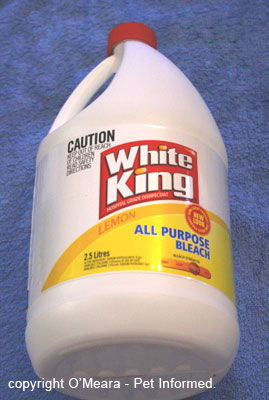 Bleach.
Bleach.
A simple, readily available solution, bleach made up in water to a 1:30 solution (1 part bleach: 30 parts water) will kill parvo. The solution must be applied thoroughly to ALL contaminated surfaces and left on for at minimum of 10 minutes to be effective as a parvovirus disinfectant.
Be aware, of course, that some surfaces and materials will not tolerate bleach (it is corrosive at high concentrations). Also be aware that bleach is not safe to breathe in (there are lots of warnings on the labels). The bleach should ideally only be used in well-ventilated areas or, if used in poorly ventilated areas, with appropriate safety apparatus (face and eye masks, possibly even breathing apparatus). Once applied and given time to act, the bleach must be rinsed thoroughly, leaving no residues, and the area allowed to ventilate well before animals can be reintroduced to the area. If it is not rinsed away well, bleach can cause severe ulcers to the skin and mouths of animals that walk on or lick it.
Aldehydes.
Aldehyde chemicals such as formaldehyde (formalin) and glutaraldehyde and other closely related substances are high-level disinfectants which are able to kill parvoviral organisms. Available as liquid disinfectants or as gasses, these chemicals are often used in the sterilization of sensitive optical equipment and equipment that is sensitive to heat and other chemicals. The liquid forms, however, are readily available and are able to be used on premises to kill parvovirus. The contact time required is around 12 minutes.
I would suggest getting professional advice if considering using formaldehyde or one of its relatives to disinfect for parvo. The substance is really nasty. It releases noxious vapors that irritate the airways and nasal passages and it is highly carcinogenic (cancer causing). It should ideally only be used in well-ventilated areas or, if used in poorly ventilated areas, with appropriate safety apparatus (face and eye masks, possibly even breathing apparatus). Once applied and given time to act, aldehydes must be rinsed thoroughly, leaving no residues, and the area allowed to ventilate well before animals can be reintroduced to the area.
Ethyl alcohol.
Ethyl alcohol at between 50-95% concentration (i.e. containing some water) has been found to kill off viruses such as parvo. It is useful for small areas of contamination (e.g. skin regions and small instruments), but is not really practical for large-scale disinfectant purposes because it evaporates so quickly and keeps needing to be reapplied to be effective. I would steer clear from this one in a case of parvo. It has the potential to be unreliable.
Ethylene Oxide.
This is a powerful gaseous chemical which is able to kill most infectious disease organisms. It is generally only available in hospitals to sterilize equipment, however, it could potentially be applied to contaminated canine fomites (dog feed bowls, grooming gear) in order to kill parvo. I would consider it to be too cost prohibitive and equipment intensive to be a real practical consideration for the average dog breeder or householder.
The chemical agents vet clinics use to kill parvovirus.
Veterinary clinics across the world use a large range of chemical disinfectants to rid their premises of parvovirus. I can not name them all here since the chemicals themselves and the trade names of the various products containing these chemicals differ from country to country. In Australia, however, the most common chemical disinfectants utilised against parvovirus include Virkon-S and Trigene.
Virkon-S is the product our clinic uses to kill parvovirus.
Trigene acts against a wide range of bacteria, viruses, fungi and other organisms in a short period of time. It is quite irritant to airways and, like any strong disinfectant, should be used in well-ventilated areas and not breathed-in. To kill parvovirus, Trigene is diluted to a 1:50 concentration and must maintain contact with parvo-contaminated surfaces for a minimum of 20 minutes (the longer you can leave it, the better the effect). 1:100 dilutions can work too if left for a minimum of 30 minutes and 1:20 dilutions can kill parvo in 5 minutes, but are very noxious. After use, the Trigene should be rinsed thoroughly and the region dried well and well-aerated before reintroduction of an animal.
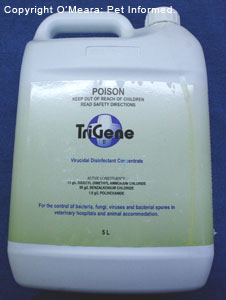
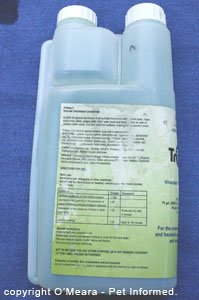
F10?:
F10 is non-toxic and non-corrosive and minimally irritant but, like any strong disinfectant, should be used in well-ventilated areas and not breathed-in. According to the label, to kill parvovirus, F10 must be diluted to a 1:125 concentration and must maintain contact with parvo-contaminated surfaces for a minimum of 30 minutes. After use, the F10 should be rinsed thoroughly and the region dried well before reintroduction of an animal.
My concern with this product's parvo claims is that it contains quaternary ammonium compounds and biguanides, neither of which is particularly effective at killing non-enveloped viruses like parvo. A recent shelter vet conference I attended featuring a vet from UC Davis discussed this product and her recommendation was to avoid F10 for parvoviral disinfection as it was considered not highly effective.
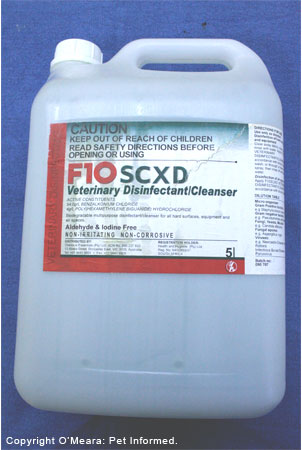
Non-chemical agents used to kill parvovirus.
Steam-cleaning.
Parvo is a highly resistant organism, but it is not resistant to intense heat and pressure. Steam cleaning will kill parvo organisms and may be an option for carpets and clothing and bedding where bleach might not be appropriate. Autoclaving (whereby hospitals and vet clinics use intense pressure and heat to sterilise surgical equipment) is a good way of removing infectious parvo from steel fomites, instruments and cloth materials.
When using steam to kill off infectious organisms, it is important that adequate temperatures be achieved (around the 120-130 degrees-Celsius mark), that adequate pressures be achieved (around 15-20 psi) and that adequate contact time is maintained. 10-15 minutes is needed, depending on the temperature and pressure used, to achieve the desired effect.
Remove the infected surfaces.
This is an expensive way to remove infectious disease organisms, however it does work. Routinely replacing gravel, topsoil or lawn surfaces that have become contaminated and replacing them with new, fresh, non-contaminated surfaces is an excellent way to remove infectious disease organisms. If the difficult-to-clean infectious surfaces (soil, lawn etc) can be replaced with a new, easy-clean surface such as concrete or tiles or metal (in the case of runs and cages), so much the better.

13. Summary and take home messages:
Puppies which are unvaccinated or under vaccinated are at risk of contracting parvovirus if they are taken out into public places or allowed to meet other animals. Any environment anywhere that could have been contaminated with faeces could be potentially infective to unvaccinated dogs.
Certain breeds are particularly prone to parvo.
The virus lasts for years in some environments and is very resistant to most disinfectants and chemicals.
The signs of parvovirus include: vomiting, bloody (hemorrhagic) diarrhea, abdominal pain, dehydration, shock and fever. Vomiting can precede most of the other signs (it may be the first sign observed by an owner).
Parvo is expensive and sometimes difficult to treat. Puppies will need to be kept in isolation at a vet clinic and placed on intravenous fluids, possibly for a week or more. Some puppies will need expensive treatments such as special fluids, intravenous antibiotics and plasma to save them. Some may even need surgery to treat parvo-associated complications (e.g. intussusception).
Many severely affected puppies will die from infection or heart complications, despite what we do.
Insurance companies may not cover the costs of this treatment - many exclude vaccine-preventable diseases, such as parvo, from their coverage.
Prevention is definitely the best form of treatment. Prevention is achieved using vaccinations and controlling where the puppy is allowed to go (particularly when it is not fully vaccinated).
In high risk parvo situations, complex plans of facility management and new protocols (e.g. vaccine protocols, isolation protocols, quarantine protocols, cleaning and disinfection protocols) may need to be put into place to reduce the spread of disease.

To go from our Canine Parvovirus page to the homepage, click here.

References and Suggested Readings:
1) Prevention of Infectious Diseases. In Nelson RW, Couto CG, editors: Small Animal Internal Medicine, Sydney, 1998, Mosby Inc.
2) Greene CE, Immunoprophylaxis. In Greene CE, editor: Infectious Diseases of the Dog and Cat, St. Louis, 2006, Saunders Elsevier.
3) Greene CE, Canine Viral Enteritis. In Greene CE, editor: Infectious Diseases of the Dog and Cat, St. Louis, 2006, Saunders Elsevier.
4) Greene CE, Environmental Factors in Infectious Disease. In Greene CE, editor: Infectious Diseases of the Dog and Cat, St. Louis, 2006, Saunders Elsevier.
5) Greene CE, Prevention and Management of Infection in Kennels. In Greene CE, editor: Infectious Diseases of the Dog and Cat, St. Louis, 2006, Saunders Elsevier.
6) Hoskins JD, Canine Viral Diseases. In Ettinger SJ, Feldman EC, editors: Textbook of Veterinary
Internal Medicine, Sydney, 2000, WB Saunders Company.
7) General Characteristics and Classification of Viruses. In Carter GR, Chengappa MM, Roberts AW editors: Essentials of Veterinary Microbiology, USA, 1995, Williams and Wilkins.
8) Immunotherapy. Wroth O, editor: MIMS IVS Annual, St Leonards, 2001, Havas MediMedia.
9) Immunotherapy. Wroth O, editor: MIMS IVS Annual, St Leonards, 2004, Havas MediMedia.
10) Information on DuramuneAdult C3 taken from information provided by Fort Dodge Australia Pty Limited, 2007.
11) Information on Nobivac DHP and Nobivac KC taken from information provided by Intervet Australia Pty Limited, 2007.

Pet Informed is not in any way affiliated with any of the companies whose products
appear in images or information contained within this article. The images, taken by Pet Informed, are only used in order to illustrate certain points being made in the article.
Copyright March 15, 2008, www.pet-informed-veterinary-advice-online.com.
Modified April 7, 2008.
All rights reserved, protected under Australian copyright. No images or graphics on this Pet Informed website may be used without written permission of their owner, Dr. O'Meara.
Duramune, Protech and Fort Dodge are registered trademarks of Wyeth and its affiliates.
Nobivac and Companion C3 are registered trademarks of Intervet.
Baytril is a registered trademark of Bayer Australia Ltd.
Metrin is a registered trademark of Parnell Laboratories Australia Pty Ltd.
Zantac is a registered trademark of GlaxoSmithKline.
White King is a registered trademark of Sara Lee.
TriGene is a registered trademark of Medichem International.
F10 SCXD is a registered trademark of Health and Hygiene.
Please note: the aforementioned puppy vaccination schedules, adult dog vaccination
guidelines, pregnancy vaccination guidelines and information on the new immunization schedules now being made available are general recommendations only.
The information provided is based on published information and recommendations made available from the vaccine companies themselves; relevant veterinary literature
and publications and my own experience as a practicing veterinarian.
The advice given is appropriate to the vast majority of pet owners however, given
the large range of vaccine types and protocols now available, owners should take it upon themselves to ask their own veterinarian what vaccination schedules s/he is using so as
to be certain what to do. Owners with specific circumstances (high parvovirus
contamination in environment, black and tan dog breeds, pregnant bitches, animals on immune-suppressant medicines etc. etc.) should ask their vet what the safest and
most effective protocol is for their situation.
Any dose rates mentioned on these pages should be confirmed by a vet. Dosing rates for common
drugs are being changed and updated all the time (e.g. as new research comes in and as drug
formulations change) and information here may not remain current for long. What's more, although we try very hard to maintain the accuracy of our information, typos and oversights do occur. Please check with your vet before dosing any pet any medication or drug.
 Parvo is a severe, often life-threatening disease of the intestinal tract and bone marrow (and sometimes other organs) of dogs and other canids that is caused by one of a number of strains of parvovirus. Currently, four main strains of infectious parvovirus have been identified: CPV-2 (the original virus) and its newer strains CPV-2a, CPV-2b and CPV-2c.
Parvo is a severe, often life-threatening disease of the intestinal tract and bone marrow (and sometimes other organs) of dogs and other canids that is caused by one of a number of strains of parvovirus. Currently, four main strains of infectious parvovirus have been identified: CPV-2 (the original virus) and its newer strains CPV-2a, CPV-2b and CPV-2c.
 Parvo is shed into the environment in the feces of infected dogs. These dogs might be clinically affected with parvo (i.e. sick dogs with vomiting and diarrhea) or they might be non-clinical shedders of the virus (dogs that look normal, but which have nasty, replicating parvo viruses in their intestines and are passing infective particles into their stools). It is important to note that some vaccines, although they prevent a dog from becoming 'sick' with parvo, do not prevent the same animal from developing a carrier state and being at risk to other pets.
Parvo is shed into the environment in the feces of infected dogs. These dogs might be clinically affected with parvo (i.e. sick dogs with vomiting and diarrhea) or they might be non-clinical shedders of the virus (dogs that look normal, but which have nasty, replicating parvo viruses in their intestines and are passing infective particles into their stools). It is important to note that some vaccines, although they prevent a dog from becoming 'sick' with parvo, do not prevent the same animal from developing a carrier state and being at risk to other pets.  As mentioned in the opening sentences, parvo causes bloody diarrhea, vomiting, abdominal pain, dehydration, shock and severe illness in dogs affected with it. The following discussion is mostly for those of you who are interested in how the viruses works in order to create these parvo symptoms. Understanding how the virus works is useful because it aids your understanding of why certain treatments are required and why treating parvo is so darn expensive!
As mentioned in the opening sentences, parvo causes bloody diarrhea, vomiting, abdominal pain, dehydration, shock and severe illness in dogs affected with it. The following discussion is mostly for those of you who are interested in how the viruses works in order to create these parvo symptoms. Understanding how the virus works is useful because it aids your understanding of why certain treatments are required and why treating parvo is so darn expensive! The loss of the lining cells of the crypts and the villi results in ulceration and extensive bleeding of the intestinal wall. This is why we see lots of blood in the feces and vomit as the disease progresses. The severe, diffuse injury of the intestinal lining results in massive inflammation of the gut: the intestine becomes swollen and paralysed (unable to move) and a condition called ileus (non-moving gut) occurs, which results in vomiting and an inability to keep any food or fluids down. The bleeding and the massive inflammatory response that occurs in the intestines, results in enormous loss of water and body-proteins into the intestines (these are lost in the diarrhea and vomit), a loss that is further compounded by the fact that the animal can not keep any water or food down (due to vomiting) and the fact that the nutrient-absorbing cell-lining and villi have been lost (there are no cells or absorptive 'fingers' left to absorb any food that does make it to the gut). The result is massive loss of body proteins (albumin, in particular) and massive dehydration, which, if left untreated, will lead to shock and death.
The loss of the lining cells of the crypts and the villi results in ulceration and extensive bleeding of the intestinal wall. This is why we see lots of blood in the feces and vomit as the disease progresses. The severe, diffuse injury of the intestinal lining results in massive inflammation of the gut: the intestine becomes swollen and paralysed (unable to move) and a condition called ileus (non-moving gut) occurs, which results in vomiting and an inability to keep any food or fluids down. The bleeding and the massive inflammatory response that occurs in the intestines, results in enormous loss of water and body-proteins into the intestines (these are lost in the diarrhea and vomit), a loss that is further compounded by the fact that the animal can not keep any water or food down (due to vomiting) and the fact that the nutrient-absorbing cell-lining and villi have been lost (there are no cells or absorptive 'fingers' left to absorb any food that does make it to the gut). The result is massive loss of body proteins (albumin, in particular) and massive dehydration, which, if left untreated, will lead to shock and death. The ulceration of the intestine allows bacteria normally present in the gut to enter the blood stream. These bacterial levels in the small intestine can be very high because the gut is not moving (movement of the gut is a normal mechanism by which excessive populations of bacteria get cleared from intestine through the feces). If the gut does not move, bacteria will just brew away in the unmoving regions of the gut, their populations expanding to massive levels. Bacteria infection of the blood (termed bacteremia, septicemia or blood poisoning) is very nasty, resulting in extensive inflammation and damage to many blood vessels and organs (e.g. lung, kidney) and severe septic shock (which can often be fatal).
The ulceration of the intestine allows bacteria normally present in the gut to enter the blood stream. These bacterial levels in the small intestine can be very high because the gut is not moving (movement of the gut is a normal mechanism by which excessive populations of bacteria get cleared from intestine through the feces). If the gut does not move, bacteria will just brew away in the unmoving regions of the gut, their populations expanding to massive levels. Bacteria infection of the blood (termed bacteremia, septicemia or blood poisoning) is very nasty, resulting in extensive inflammation and damage to many blood vessels and organs (e.g. lung, kidney) and severe septic shock (which can often be fatal).

 Plasma is the fluid left when you remove all of the cells from blood. It contains loads of really helpful substances that can really make a huge difference to the survival chances of parvo puppies.
Plasma is the fluid left when you remove all of the cells from blood. It contains loads of really helpful substances that can really make a huge difference to the survival chances of parvo puppies.  Some patients lose so much blood as a result of gastrointestinal ulceration that they can actually become severely anemic in addition to losing protein into the gut.
Some patients lose so much blood as a result of gastrointestinal ulceration that they can actually become severely anemic in addition to losing protein into the gut. 





 The reason I have included a piece on the costs of parvo therapy is not to discourage you from treating parvo, but to make you well-informed of what is entailed. The moderate to severe cases are often very expensive and not for the financially faint-hearted. They aren't the kind of cases that can generally be managed by trying a couple of small, inexpensive measures, just to 'see if it works': in my experience, these pups tend to deteriorate quickly and sometimes unexpectedly. In my opinion, severe parvo cases are "all-in or not-in" cases: you either get them treated properly (understanding everything that this intensity of treatment might entail) or be prepared to end up with a very expensive, deceased puppy. Remember that, even if your puppy is treated with the very best treatment money can buy (thousands of dollars-worth in some cases), many of these puppies are simply too unwell and weak and young to survive.
The reason I have included a piece on the costs of parvo therapy is not to discourage you from treating parvo, but to make you well-informed of what is entailed. The moderate to severe cases are often very expensive and not for the financially faint-hearted. They aren't the kind of cases that can generally be managed by trying a couple of small, inexpensive measures, just to 'see if it works': in my experience, these pups tend to deteriorate quickly and sometimes unexpectedly. In my opinion, severe parvo cases are "all-in or not-in" cases: you either get them treated properly (understanding everything that this intensity of treatment might entail) or be prepared to end up with a very expensive, deceased puppy. Remember that, even if your puppy is treated with the very best treatment money can buy (thousands of dollars-worth in some cases), many of these puppies are simply too unwell and weak and young to survive. 
 - Puppies should be fed a completely balanced (AAFCO approved) puppy diet.
- Puppies should be fed a completely balanced (AAFCO approved) puppy diet.
 Bleach.
Bleach.

